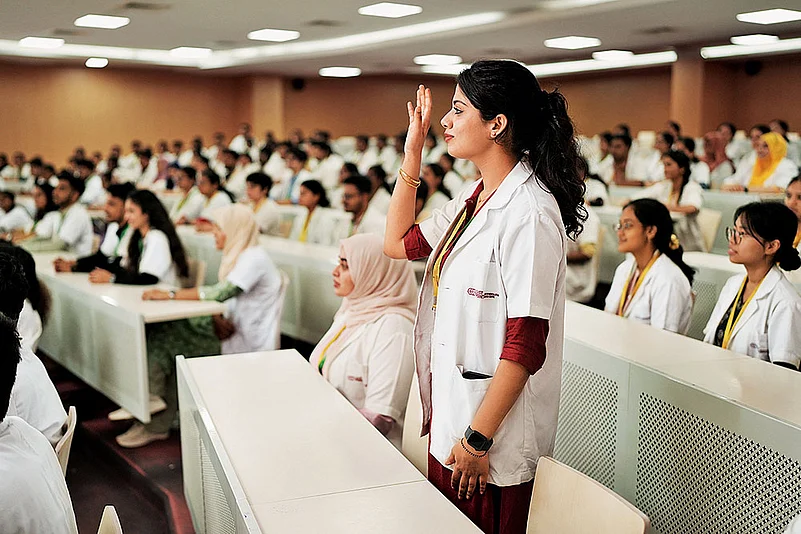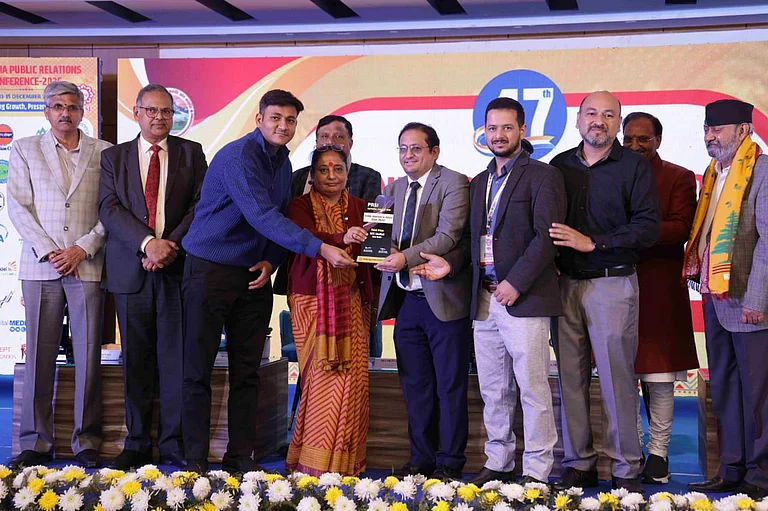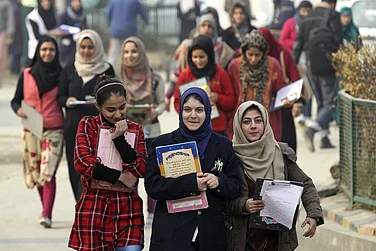In academia, publishing a research paper was historically regarded as the apex of meticulous thought, experimentation, and sincere investigation. Currently, academic publishing is confronting an existential crisis. The swift increase in fraudulent activities, exploitative journals, and large-scale counterfeit paper production has jeopardised the credibility of science. Beyond the headlines exists a stark reality: the deterioration of publication ethics is not a peripheral issue but a systemic problem. The crisis increasingly involves qualitative decline and is supported by alarming statistics.
The “Publish or Perish” Phenomenon: Catalysing the Ethical Crisis
The “publish or perish” mentality is the publication crisis’s core. Scholars must publish regularly for academic promotions, grant approvals, and job retention. This intensely competitive landscape compels numerous individuals to navigate ethical ambiguities.
The global volume of scientific publications has surged. In 2000, approximately 1.3 million articles were published each year. By 2022, the figure had increased to over 2.8 million, as per Scopus data. This increase may imply a robust research culture, yet it frequently conceals the rise of substandard and unethical research.
In India, institutional mandates exacerbate this pressure. The University Grants Commission (UGC) previously mandated that Ph.D. students publish in sanctioned journals, along with the pressure to get publications for rankings and accreditation, inadvertently validating numerous predatory publishers. Despite the revision of this policy in 2019, its effects persist in universities and research institutions.
Paper Mills: Industrial Production of Deceptive Research
A significant factor in the integrity crisis is the emergence of paper mills, commercial entities that manufacture scientific papers and sell authorship rights. These organisations supply fabricated data, graphs, and even pre-composed peer reviews, delivering publication-ready manuscripts for a fee.
In 2023, more than 10,000 scientific papers were retracted worldwide, marking a record high. A considerable proportion of these retractions were associated with paper mills. Prominent publishers such as Wiley and Hindawi were compelled to retract over 11,300 papers, many of which had successfully passed peer review without detection. In response, Wiley discontinued 19 compromised journals.
The “publish or perish” mentality is the publication crisis’s core. Scholars must publish regularly for academic promotions, grant approvals, and job retention
One analysis estimated that as much as 2% of all manuscripts submitted to reputable publishers resemble those generated by paper mills. A separate study revealed that at least 400 journals had published articles derived from recognised fraudulent paper templates. The issue is so pervasive that tools such as “Papermill Alarm” have been created to identify stylistic and structural irregularities characteristic of such frauds.
Predatory Journals: Capitalising on Ambition and Naivety
Paper mills produce deceptive research, while predatory journals act as their dissemination channels. These journals, frequently masquerading as open access, guarantee expedited publication for a fee while entirely omitting peer review.
A 2015 study by Shen and Björk estimated that more than 420,000 articles were published in predatory journals within a single year, spanning over 8,000 journals. The figure is anticipated to have risen substantially in recent years.
The effects are evident in India. In 2023, Padma Shri awardee Dr. Himmatrao Bawaskar disclosed that a predatory journal published his manuscript without authorisation and requested a payment of Rs 1.5 lakh. Upon his refusal, the journal threatened legal proceedings, highlighting the pervasive exploitation of naive or desperate researchers.
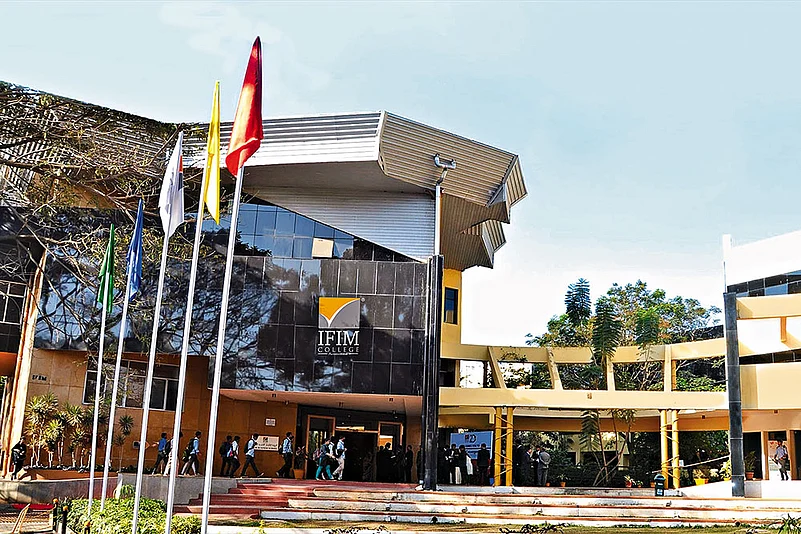
Predatory journals frequently misrepresent their editorial boards, exhibit fraudulent impact factors, issue aggressive publication solicitations, and accept submissions within 24 to 72 hours without conducting reviews. Academics in developing countries, who may be deficient in awareness or direction, are particularly susceptible. India, Nigeria, and Iran rank among the foremost contributors to these journals.
The Replication Crisis: An Indication of Profound Deterioration
Even in reputable journals, replication of findings is becoming increasingly complex, a phenomenon referred to as the replication crisis. The statistics presented are alarming.
A 2016 survey published in Nature involving more than 1,500 scientists revealed that 70% were unable to replicate another scientist’s experiment, while over 50% could not reproduce their findings. Psychology, medicine, and economics are the most adversely affected disciplines.
Even in reputable journals, replication of find ings is becoming increasingly complex, a phe nomenon referred to as the replication crisis
The Reproducibility Project in psychology sought to replicate 100 published studies. Only 39% produced identical outcomes. A survey by Amgen in pre-clinical cancer biology revealed that only 11% of landmark studies were reproducible. Bayer disclosed a 25% reproducibility rate in its internal evaluations.
These failures indicate inadequate methodology and reveal systemic issues in peer review, data transparency, and incentive frameworks. Despite methodological rigour, journals favour original discoveries and affirmative outcomes, disincentivising replication studies and penalising negative results.
Coercion of Citations and Manipulation of Authors: Exploiting the System
In addition to fraudulent publications and reproducibility challenges, more nuanced yet equally concerning practices exist. Coercive citation entails journal editors exerting pressure on authors to reference articles from the same journal to enhance impact factors artificially. This skews bibliometric metrics and infringes upon academic freedom.
A survey by Wilhite and Fong (2012) revealed that 20% of researchers felt compelled to include irrelevant or unnecessary citations. Certain editors correlate publication decisions with citation adherence.
The ethics of authorship are equally ambiguous. Honorary authorship, which includes senior academics who contributed nothing substantial, is pervasive. Conversely, “ghost authorship” obscures the contributions of individuals deserving of recognition, such as junior researchers or industry writers.
A study published in JAMA revealed that 19% of articles in six prominent medical journals included honorary authors, while 11% featured ghost authors. This manipulation distorts credit attribution and undermines authentic scientific efforts.
Fundamental Factors Contributing to Ethical Deterioration
Comprehending the crisis in publication ethics necessitates examining underlying structural issues.
Incentive Misalignment: Academic reward systems emphasise the volume of publications rather than their quality or impact. This compels researchers to pursue facile successes and rapid publications.
Commercialisation of Research: The academic publishing sector constitutes a multi-billion-dollar industry. Major publishers generate over $3 billion annually, primarily from institutional subscriptions and open-access fees. The profit motive frequently supersedes editorial accountability.
Insufficient Oversight and Policy Implementation: The guidelines provided by the Committee on Publication Ethics (COPE) are advisory and are enforced inconsistently. Numerous universities lack internal ethics committees or training initiatives for research integrity.
Researchers from the Global South, including India, encounter linguistic, infrastructural, and mentorship obstacles, rendering them vulnerable to predatory journals and unethical publishers.
Strategies: Restoring Trust and Accountability
The crisis is not insurmountable. Various policy-based, institutional, and cultural interventions can reinstate credibility in academic publishing.
Enhancing Peer Review and Detection: Journals ought to allocate resources towards AI-driven instruments for plagiarism detection, image forensics, and text analysis to identify content generated by paper mills. Implementing open peer review, in which reviewers’ identities and evaluations are disclosed, can augment transparency.
Promoting Replication and Negative Outcome: Funding organisations and academic journals must proactively endorse replication studies. Registered Reports, in which study designs undergo peer review before the disclosure of results, can mitigate p-hacking and selective reporting.
Revamping Academic Incentives: Promotion and grant systems must transcend the fixation on impact factors. Initiatives such as the San Francisco Declaration on Research Assessment (DORA) advocate prioritising research quality and societal impact over mere citation metrics.
Instructing Researchers: Publication ethics should be integrated into university curricula for doctoral candidates. Workshops, mentorship, and access to COPE resources can enhance awareness.
In addition to fraudulent publications and re producibility challenges, more nuanced yet equally concerning practices exist
Surveillance and Exclusion of Exploitative Publishers: Organisations like the UGC and the National Research Foundation (NRF) should sustain current allowlists of reputable journals and issue cautions regarding predatory publications. Collaborating with Retraction Watch and indexing services can assist in monitoring unethical individuals.
Advocating for Diamond Open Access: Unlike gold open access, which requires authors to pay, diamond open access models are complimentary for readers and authors and financed by institutions or consortia. They provide a fair alternative to profit-oriented publishing.
Restoring the Credibility of Science
Notwithstanding the despondency, optimistic transformations are surfacing initiatives such as Retraction Watch, which currently monitors more than 55,000 retracted publications, fostering transparency. Wiley, Elsevier, and Springer Nature have intensified their examination of submissions and established more stringent editorial standards. The Centre for Open Science and initiatives like the Open Science Framework are developing tools to enhance reproducibility and data transparency. India’s proposed National Research Foundation (NRF) has highlighted the importance of ethical research, mentorship, and funding reforms. These advancements indicate that the global research community is addressing the crisis with gravity.
The data is unequivocal. The credibility of academic publishing is jeopardised by over 10,000 retractions in one year, hundreds of thousands of articles in predatory journals, and replication success rates below 40% in specific fields. However, numbers also provide guidance. We can reverse the deterioration by prioritising peer review, incentivising thoroughness over expediency, and ensuring accountability for unethical behaviour. It is not solely about preserving journals; it is about protecting the very essence of science.
A publication transcends mere metrics. It signifies trust. Trust must be cultivated, not fabricated.
Methodology 2025
The Outlook ICARE Rankings 2025 India’s Best Professional Colleges utilize a comprehensive and rigorously designed framework to evaluate higher education institutions across five core dimensions: Academic and Research Excellence, Industry Interface and Placement, Infrastructure and Facilities, Governance and Extension, and Diversity and Outreach. Each broad category is broken down into specific sub-parameters, with assigned weightages contributing to a cumulative score out of 1000. Data for the rankings is primarily collected through structured institutional surveys and verified through supporting documentation. It is cross-referenced with credible third-party sources such as AISHE, NAAC, and NIRF.
The methodology underpinning these rankings results from several years of sustained research and refinement. It has been shaped through continuous engagement with academic leaders, vice-chancellors, deans, and subject matter experts, and through reviews of national and international literature on higher education quality assessment. Trend analysis from data spanning 2016 to 2024 has informed many of the framework’s improvements. Notably, the methodology remains dynamic, incorporating feedback from stakeholders and adapting to new data sources, sectoral developments, and shifts in the higher education landscape.
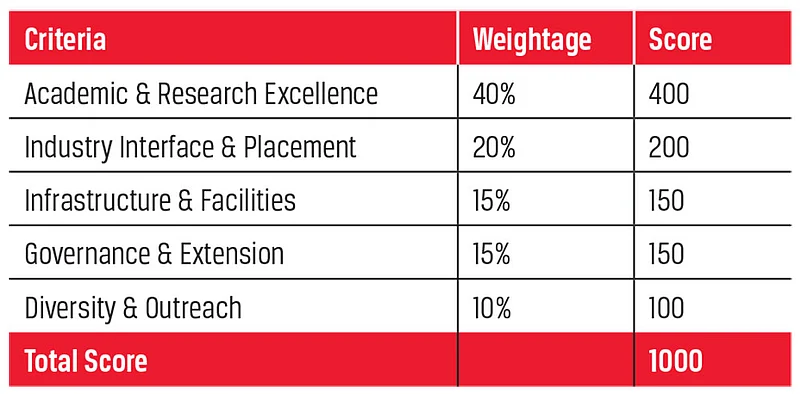
The final rankings are determined by aggregating scores based on the following weightages: Academic and Research Excellence (40%, 400 points), Industry Interface and Placement (20%, 200 points), Infrastructure and Facilities (15%, 150 points), Governance and Extension (15%, 150 points), and Diversity and Outreach (10%, 100 points). The scores for each parameter are normalized and combined to yield a final score out of 1000, enabling a fair and holistic comparison of institutions across India.
MORE FROM THIS ISSUE
Dr Karthick Sridhar Vice Chairman, ICARE






